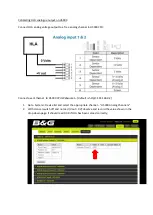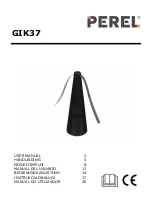
42
ECO II FEEDING rev.06
ECO II FEEDING
5.9
Identification Numbers and Relay Assignment
Identification numbers
The controller can communicate with its external modules to activate relays or to
receive information from the proximity switches for instance. Each external module
has a specific identification number so that communication can be established be-
tween the controller and its external devices. The modules’ identification numbers are
predefined;
refer to the wiring diagram to assign the proper numbers to each module.
Relay Assignment
The controller controls the activation of On/Off relays that are located in external
relay boxes. The mapping between the different devices and their relays is defined by
the user.
32 output relay panels:
Relay panels with 32 outputs
have 2 identification num-
bers: one ID number identi-
fies the first 16-relay strip
(relays 1-16) whereas the second ID
number identifies the second relay strip
(relays 17-32). Since the controller
does not make the difference between
relays 1-16 and relays 17-32, it thus
refers to the identification number to
know on which strip each relay is
located.
Templates are available at the end
of this manual to make the assignment easier.
Do not make changes to the relay assignment
while a feed cycle is running!
32 OUTPUT
RELAY PANEL
SECOND 16-RELAY
STRIP’S ID #
FIRST 16-RELAY
STRIP’S ID #
RELAYS 1-16
OF THE FIRST
16-RELAY STRIP
RELAYS 1-16 OF THE
SECOND 16-RELAY
STRIP (= RELAYS 17-32)
35
ECO II FEEDING rev.06
ECO II FEEDING
5.6
Loop Settings
Feed lines that are used for feed transportation are called loops. Two different loop
systems can be used : flexible auger loop systems and/or closed-loop systems. Refer
to section 5.3 to enable the proper loop type and to set the number of loops in use.
Graphics illustrating both systems are shown in section 2.3.
Simultaneous feed batches’ transit:
Up to 10 different feed batches, each having a specific destination, can transit simul-
taneously in the loop(s). The simultaneous feed distribution process is based on the
loops’ speed and on the distance that separate the different drops from the feed’s
entry point.
Even though many feed batches can transit in the loop, only one drop can be served
at a time; for this reason, the controller defines a clearance between consecutive feed
batches as follows:
A minimum distance between the feed batches in the loop is first defined by the user
(in feet). This distance must be equal or greater than the maximum distance that is
likely to separate two consecutive electric drops. A correction parameter is then added
to this distance, depending on how far the drop that needs to be served is from the
feed’s entry point; this correction factor is called the Loop Slip. Finally, a distance that
corresponds to the drops’ opening and closing times is added to the distance that
separates the batches.
In other words, the
total distance
between different feed batches =
Minimum di slip distance for the opening/closing of the drops.
The following diagram illustrates this situation.
The feed drop that is being served slightly opens before the feed’s arrival and closes a
little after the feed’s passage to receive remaining feed residues.
DROP 3 FEED
Distance from
drop 3= 100 ft
Loop slip (5%) :
5% of 100 ft = 5 ft
DROP 2 FEED
Distance from
drop 2 = 300 ft
Loop slip (5%):
5 % of 300 ft = 15 ft
DROP 1 FEED
200 ft
min. distance
5ft
slip
Total distance
200 ft
min. distance
15 ft
slip
Total distance
drops’
open/close
time
drops’
open/close
time
Graphic: distance between feed batches















































